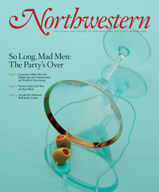
You’ve Come a Long Way, Baby
Terry Stephan (GJ78) is a freelance writer in Chicago.
Tell us what you think. E-mail comments or questions to the editors at letters@northwestern.edu.
Ever wonder about those strange designations we use throughout Northwestern to identify alumni of the various schools of the University? See the complete list.
Find Us on Social Media
Advertising is no longer a Mad Men’s world. It’s all about marketing, analytics, social media — and putting the customer first.
The advertising agency culture, best depicted by AMC’s hit TV show Mad Men, was on its way out by the early 1970s, a victim of the growing feminist movement, the 1964 surgeon general’s report on smoking and some sober reflection on the drawbacks of the three-martini lunch.
But it wasn’t entirely gone, and Mark Goldstein (J69, GJ70) saw it firsthand as a copywriter at Leo Burnett. “It was the end of the Mad Men era, but all the vestigial remains were still in bloom,” he recalls. “Political incorrectness ruled the day. Three-hour lunches were not unusual. Executives having affairs in their offices with secretaries or younger employees never raised an eyebrow.”
Over the years Goldstein worked on ads for a variety of industries including airlines, financial services and automobiles. He wrote most of the print ads for Virginia Slims from 1972 to 1975, using the cigarette-maker's famous slogan: “You’ve come a long way, baby.”
“I worked on the creative team that did Virginia Slims, Kentucky Fried Chicken and Wilson Sporting Goods,” he says. “That was a time when cigarettes, fried foods and wooden tennis rackets were still in vogue.”
Jeanie Lindburg Caggiano (C82, GJ83) saw remnants of agency life’s colorful past at the start of her now nearly 30 years at Leo Burnett, where she currently serves as executive vice president and executive creative director. “When I started, most of the creatives were men,” she says. “Most of the account people were too. Skirt-chasing, drinking at lunch, drinking after work, hiring strippers for birthday parties — I’ve seen it all.”
During her time at Burnett, Caggiano has worked in every media, from billboards to print, broadcast and digital. “I’ve even done matchbook covers and parking lot bumpers,” she says. Since 2010 she has headed up the “Life Is a Special Occasion” brand campaign for Hallmark. It is designed to change the company’s persona from one that makes greeting cards to one that is “a creator of inspiration that helps consumers make any day a special occasion.”
For 11 years she led the Allstate account and created the extremely successful “Our Stand” campaign that features actor Dennis Haysbert, who played the president in the TV series 24. “He was my pick for the campaign I wrote,” she recalls. “That did an important job of making Allstate a trusted insurance company. It allowed us, after seven years, to do ‘Mayhem.’” The Mayhem character, aimed at younger, male viewers, keeps finding himself in dicey and dangerous situations similar to those that can befall car owners. “There are hard sells,” she says of ad pitches to clients. “This wasn’t one. The client loved it.”
The realities of today’s global, highly competitive advertising world have changed much of the colorful character of agencies in the past. “In some ways, the agency business today is smaller than it was before. The core ad agency is focused on strategic planning and creative,” says Tom Carey (GJ67), who spent more than 35 years in the business before retiring in 2003 as an executive vice president of Omnicom Group. “Service to clients is much more about knitting together the multiple media choices and getting different companies — media, promotion, event marketing, public relations, etc. — to work together. And technology has made advertising investment far more measurable and accountable than ever before.
“That’s why the liquid lunches and client schmoozing of yesteryear bear little resemblance to the analytics and accountability of today,” says Carey. “Today’s account managers are less salespeople and more marketers.”
Dan Fietsam (GJ88), chief creative officer at Energy BBDO, thinks changes in the industry have been greater in the past five years than in the previous 15 because of the Internet and the economy. “The Internet,” he explains, “because it is a fundamentally interactive and behavioral system versus the traditional one-way and static media. The economy, because it is a ubiquitous force, like gravity, that affects everybody and everything. The cultural shift we’ve been evolving through from ‘irrational exuberance’ [Alan Greenspan’s 1996 phrase about the overvalued stock market] to ‘we’re screwed’ influences and drives every business and consumer decision. It certainly has directed creative decision-making and output toward more proven and quantifiable ideas versus the instinctual and visionary ones.”
Fietsam says jobs in advertising have always been competitive, but 20 years ago “I think the agencies took more chances on ‘experimental’ creative hires. There were more stories of stand-up comics, law school dropouts, mechanics and temp secretaries getting hired just because they brought an unconventional perspective and could write or make art. Creative talent 20 years ago was more raw and less savvy about how the business worked than the youngsters are today. I’m not saying it’s good or bad, it’s just the way it was.”
Brad Todd (GJ71) is a principal at the Richards Group, the largest independent advertising agency in the United States. Dallas-based, it has approximately 600 employees. “Independence is the hallmark of our agency,” he says. We have no absentee owner and no outside investors. Therefore our focus is not to make shareholders happy; it is to do the best work for our clients every day.” Those clients have included Motel 6, Chick-fil-A, 7-Eleven, MD Anderson Cancer Center and Continental Airlines.
Todd says the digital side of the business is where the jobs are. “Consumers equate web presence with reputation, so the online world clearly is a huge focus for the industry,” he says. “As many have come to realize, digital work should not be delegated to a specialty unit. It needs to be an area of expertise that everyone in advertising assumes.
“The digital and social media world is not just a megaphone; it is two-way communication between consumers and brands,” Todd continues. “If brands aren’t listening, the companies can be assured that their consumers are not listening to them either. The digital world presents so many more options for reaching consumers, capturing quantitative data and measuring results. The change in Northwestern’s graduate advertising program to integrated marketing communications was a foretelling of these changes, to be sure.”
Don Schultz joined the Medill School of Journalism, Media, Integrated Marketing Communications faculty in 1977 after earning a PhD in mass media from Michigan State University, which followed a decade in the agency business. The master’s program in advertising then was small, only about 40 to 45 students.
“The program was running along very well,” says Schultz, professor emeritus of integrated marketing communications. “We were focused almost entirely on preparing people to go into agencies. If they wandered off into a client job or into the media, they had clearly lost their way! We were essentially a training ground for the big agencies that did not have training programs.”
In time, agency consolidation and changing agency needs caused Medill to rethink the program. Schultz was given the task of “solving the problem” and refocusing the program. It was around the same time that Dick Christian (KSM49), a co-founder and former president of the Marsteller Inc. ad agency, left the firm for Medill in 1984 to serve as associate dean and professor of advertising. Christian (see "In Memoriam," winter 2009) and Schultz huddled together to set the direction for the expanded program. The result was the addition of two more tracks to the curriculum — direct and database marketing and corporate public relations.
By the end of the 1980s the realities of the marketplace led to another major change — the creation of the integrated marketing communications degree program and the end of the master’s degree in advertising. The first students were enrolled in 1991 and graduated the following year. Today, many students interested in pursuing an advertising career in copywriting or art direction go to portfolio schools or ad schools, which typically offer a two-year program that teaches them skills and helps them build a body of work to show to prospective employers.
• • •
Many IMC graduates are working in fields far different from those of the earlier advertising students.
For the past three years, Alisa Zwanger (GJ08) has worked at Mambo Media, a boutique marketing agency in Portland, Ore. The company provides a range of services to clients, including social media, web development, lead generation and fundraising. Clients include Oregon Health & Science University, the Bill and Melinda Gates Foundation and Western Union. “My specific role as lead strategist is to analyze the customers, competitors and markets online,” Zwanger says. “My goal is to figure out what the consumers’ unmet needs are and assess the industry landscape online.
“Marketing has radically changed in the past five years. Audiences are online, so brands need to be online at several touch points to build awareness of their products, services and entities.” She says that clients come to her firm to find out how to attract new customers where they converge online and how to engage them in these new digital environments. “Ultimately we hope to move the audience to take action,” she says, “fill out a form, share content or make a purchase.”
That call to action was evident in a project Zwanger did with Oregon Health & Science University’s Doernbecher Children’s Hospital and a local radio station in December 2011. The two had partnered for a decade to raise money during a two-day radiothon. Zwanger suggested a strategy that prompted more than 1,000 listeners to share radiothon links with their personal social networks on Facebook and inspired hundreds of meaningful comments encouraging others to give. The initiative raised $248,000. It was the most successful radiothon effort for them to date and won Mambo two industry awards.
This past September Chris Kneeland (GJ00) launched CULT, a new firm in Calgary, Alberta, that brings together Watermark advertising agency and Suitcase Interactive, a digital marketing agency. He spent most of his early career in marketing, as a marketing manager for John Deere, a senior marketing manager for the Home Depot and senior vice president of retail marketing for RAPP, a Dallas ad agency.
The decision to start the new company came from his growing frustration with traditional advertising. “The problem with advertising is it is primarily focused on creating awareness about a product or service,” Kneeland says, “and for the past few years it has been heavily focused on short-term promotional messages to drive immediate sales. What chief marketing officers really need is brand preference, and ads fall short in doing that.
“Zappos didn’t build its brand with ads,” says Kneeland. “Harley didn’t become Harley with ads. Apple did some amazing advertising, but its true cult following is from something far more substantive than ads.”
Kneeland believes that “cult-like brands” create preference by operating differently, by giving the marketplace something new and unique and by treating customers differently.

Photo by Mary Henebry
Mary Baglivo (GJ81), chief executive officer and chair of the Americas for Saatchi & Saatchi, has spent her career as a strategist and works with clients including Procter & Gamble, General Mills, JCPenney, MillerCoors and Mead Johnson Nutrition Co. Baglivo, who is also a member of the Northwestern Board of Trustees, says that no matter how technology changes or what new things influence consumers, one thing has always stayed the same. “Nothing beats a great idea,” she says. “What hasn’t changed is the importance of a great idea that is differentiating. Where people consume it has changed. But that hasn’t.”
Tom Carey agrees. He says there will always be “the search for the big idea that can transform a brand. ‘Visa, it’s everywhere you want to be’ or ‘When E.F. Hutton talks, people listen.’ That’s why today there’s still a premium on creative talent.”
Fietsam thinks he knows how to define that. “The best creative people are relentless, self-directed, media fluent, collaborative, holistic, trustworthy and have an X factor,” he notes. “In my experience the best creative people inherently have these attributes regardless of media, discipline or specific skill — from writers to film editors to social media promoters to painters and musicians.”
Schultz reflects on the changes in the industry he has studied for so long. “Advertising historically has primarily been outbound,” he says. “That is, we decide what we want to talk about and we send it out, and people are supposed to pay attention to it. The advent of the Internet changed that dramatically. It created interactivity, and consumers who were able to talk with other consumers and, more important, talk back to marketers. Suddenly they had access to a widening array of information and were given the tools to be skeptical when assessing their buying decisions.
“If you give customers a lot of information the value of traditional advertising declines,” Schultz says, “because now I have a hard time convincing you about my product or my service. Now I am required to be honest. Puffery, and all of these things I’ve made up over the years, are nice and interesting, but consumers look at them and say, ‘So what?’ ”
Now that people have been exposed to the mass media for the past 50 or 60 years, consumers are pretty smart, he says.
“And that has really changed the whole approach to advertising and marketing communications. Now we don’t start with products; we start with customers,” he says. “We try to understand who they are, what they’re concerned about and what media forms they are using, and that radically changes the way you think about the communication.
“You start trying to think about how do I get my message in front of people who I know are using the company’s marketing communication forms, as opposed to saying ‘What’s the least expensive way of sending out a whole bunch of messages.’ Now you are forced to listen to, deal with and accommodate conversations coming back at you, from the people you are sending things out to. And that’s the biggest challenge.”



 Facebook
Facebook Twitter
Twitter Email
Email


